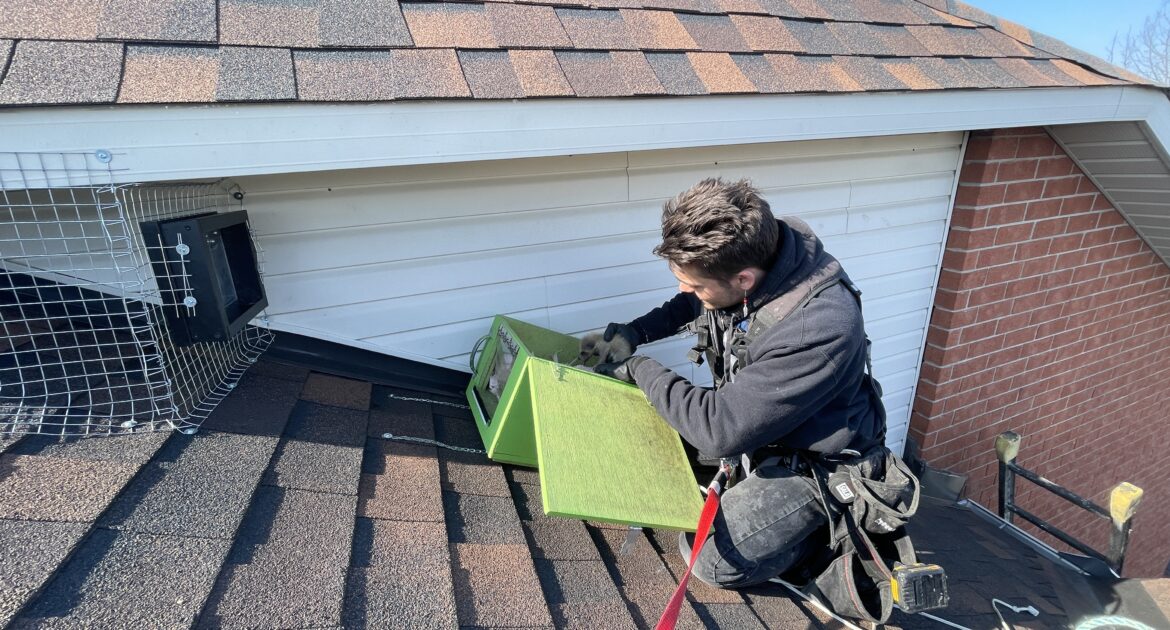To a raccoon’s eyes, a suburban neighborhood in Madison has a lot in common with the natural habitats where their species evolved. There is plentiful food, space to roam, and cozy places to hide during the day. Unfortunately, raccoon roof damage often occurs when a female raccoon chooses a human house to raise her young. Here is how to keep raccoons off your roof and out of your home.
How Raccoon Roof Damage Occurs
Weighing no more than a large terrier, raccoons obviously don’t possess the brute force of a bear roaming the neighborhood. What they do have are opposable thumbs and a highly developed sense of touch that allow them to open doors and manipulate small objects. These qualities make them one of the most destructive wild animals to have prowling around your house.
A raccoon will try to get inside your attic by clawing and tearing its way in. It doesn’t mean any harm, it is just seeking a warm and dry place to sleep and potentially raise babies. The following are types of roof damage raccoons are notorious for:
- Torn vents, soffit, and fascia
- Holes in the roof
- Damaged shingles
- Missing insulation
- Chewed wiring
How Raccoons Get on the Roof
When you watch raccoons amble around your yard or lope across the street, it is hard to imagine them maneuvering their chubby bodies very far off the ground. But despite appearances, climbing is one of the raccoon’s many skills. They can scale trees, power poles, brick walls, and skyscrapers with no problem. They can even make their way down a tree headfirst.
Figuring out exactly where raccoons are getting onto your roof is the first step in preventing their access. Adjacent trees with overhanging branches are an obvious route upward, as are light poles and drain spouts. You might notice smudges, claw marks, or hair along their nightly paths.
How To Get Rid of Raccoons on the Roof
For first-time offenders, sometimes just scaring them with loud noises is enough to make them leave. Try banging pots and pans together and yelling at them through a window. But if a raccoon has already made a den inside your attic, then no amount of commotion on your part is going to deter it from coming back. This is especially true when there are babies involved because raccoons are good mothers who will not easily abandon their litters.
Skedaddle’s approach is different from other wildlife removal services because we remove animals by hand. If there are babies inside the house, then we take them out gently, making sure that the mother carries them one by one to a new location. This is the most humane method and the only way to be sure that no animals remain inside your house.
If there are no babies yet, or if they are all old enough to follow the mother out on her nightly prowls, then we use a different technique. After inspecting the home, Skedaddle will install one-way doors in all the holes where raccoons have been entering the attic. This technology prevents raccoons from coming back in once they leave in search of food.
How To Stop Raccoons From Going on the Roof
It is a lot simpler to prevent raccoons from scaling the roof in the first place than to get them down when they are already up there. To deter them, consider trimming tree branches so they are as far from your house as possible. You can also install baffles and metal sheeting around downspouts to make them too slippery to climb.
Another way to reduce the likelihood of raccoon roof damage is to keep animals away from your property altogether. Here are a few tips for making your yard less desirable to wildlife:
- Don’t put garbage out the night before pickup.
- Bring pet food in at night.
- Remove abandoned vehicles from your property.
- Harvest fruits and vegetables promptly instead of letting them fall to the ground.
Why You Should Act Now
In Wisconsin, baby raccoon season begins in March and can last all summer. Once kits are born, they stay in the nest for two to three months. If their den is in your attic, you can imagine the amount of urine and feces that will accumulate in your insulation during a humid Madison summer.
Another reason to get help for your raccoon problem immediately is that the smell of one mammal attracts others. Skedaddle technicians have noticed that once raccoons have invaded an attic, squirrels will come by to investigate the hormonal scent of the previous tenants. Allowing professional deodorization and cleaning up of den sites reduces scent cues, which avoids attracting other species to your roof.
How Skedaddle Can Stop Raccoon Roof Damage
Are raccoons dangerous? Like any wild animal, they will defend themselves if you corner them or make them feel threatened. Mother raccoons will also fiercely defend their babies. When in doubt about how to handle a situation with any kind of wildlife, you should always call a professional.
Skedaddle can help prevent or stop raccoon roof damage by removing animals already in your home and then preventing them from coming back. We specialize in sealing entrances that many homeowners are not even aware exist and that are difficult to access. Call our Milwaukee location today to schedule your home inspection.



